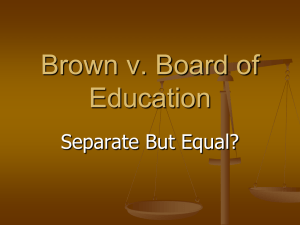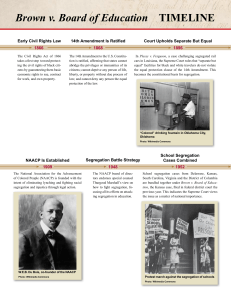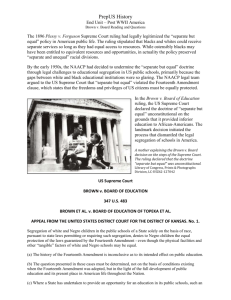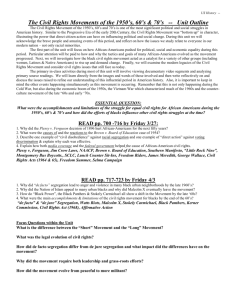The Brown Decision: What Does it Mean Today?
advertisement
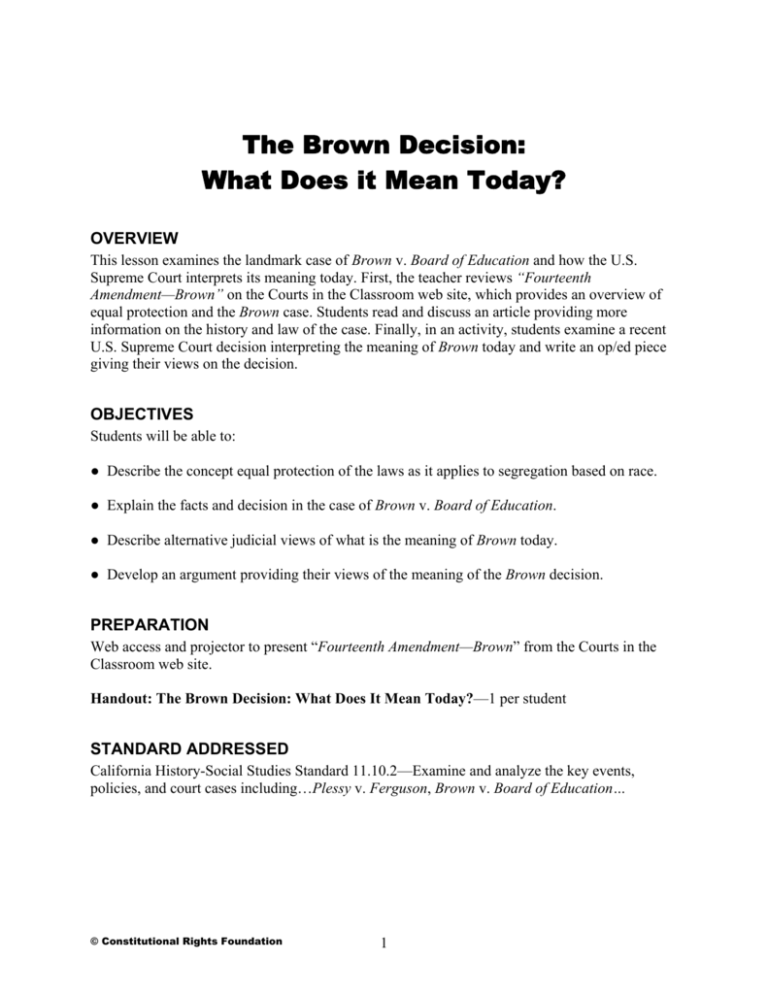
The Brown Decision: What Does it Mean Today? OVERVIEW This lesson examines the landmark case of Brown v. Board of Education and how the U.S. Supreme Court interprets its meaning today. First, the teacher reviews “Fourteenth Amendment—Brown” on the Courts in the Classroom web site, which provides an overview of equal protection and the Brown case. Students read and discuss an article providing more information on the history and law of the case. Finally, in an activity, students examine a recent U.S. Supreme Court decision interpreting the meaning of Brown today and write an op/ed piece giving their views on the decision. OBJECTIVES Students will be able to: ● Describe the concept equal protection of the laws as it applies to segregation based on race. ● Explain the facts and decision in the case of Brown v. Board of Education. ● Describe alternative judicial views of what is the meaning of Brown today. ● Develop an argument providing their views of the meaning of the Brown decision. PREPARATION Web access and projector to present “Fourteenth Amendment—Brown” from the Courts in the Classroom web site. Handout: The Brown Decision: What Does It Mean Today?—1 per student STANDARD ADDRESSED California History-Social Studies Standard 11.10.2—Examine and analyze the key events, policies, and court cases including…Plessy v. Ferguson, Brown v. Board of Education… © Constitutional Rights Foundation 1 PROCEDURE A. Web-Based Animation 1. Explain to students that in commemoration of Constitution Day, they are going to learn about an important idea contained in the 14th Amendment of the U.S. Constitution: equal protection of the law. View the segment designated “Fourteenth Amendment—Brown” from the Courts in the Classroom web site. (The flash animation discusses equal protection in terms of a female student participating on a male sports team and then provides an overview of the Brown case.) What is equal protection? (All people in the United States are entitled to equal protection. This means that laws should be applied to all people in the same way and that the benefits of citizenship should not be distributed on the basis of races, gender, religion, or national origin.) How might equal protection apply to girls playing on boys’ sports team? (Rules that exclude girls (or boys) from certain activities or programs may violate equal protection unless they are based on very good reasons.) What was the issue in the Brown case? Why was the case so important? (The issue was whether the equal protection of laws forbids segregation of students in public schools based on race? It was important because many schools were segregated at the time as were many other public facilities and institutions. The Court decision in this case could affect all of these situations.) B. Reading and Discussion—The Brown Decision: What Does it Mean Today? Explain to students that now they are going to take a closer look at the Brown case and a recent case that interpreted its meaning for today. Distribute and have students read the Handout. When students have completed the reading, hold a class discussion using the following questions 1. What was the Supreme Court’s decision in Plessy v. Ferguson? What effect did this decision have? (The decision set the precedent that racial segregation was permitted under the 14th Amendment as long as the facilities for blacks were of equal quality to those set aside for whites.) 2. Why do you think NAACP attorneys chose graduate schools as their first line of attack on the doctrine of separate but equal? (Consider a range of reasonable opinions including that they thought education to be of great importance; they were anxious to provide opportunities for young blacks to be prepared for leadership; they thought that the integration of these institutions would be less controversial than all schools; they thought it would be easier to convince judges that integrating society as a whole and wanted to build on the precedents that might be set.) © Constitutional Rights Foundation 2 3. What was the Supreme Court’s decision in Brown v. Board of Education? How was this decision extended in later cases? (The court overruled the separate, but equal doctrine and found racial segregation did violate the equal protection clause of the 14th Amendment.) 4. Do you agree with the Brown II decision? Explain (Consider a range of reasonable opinions as ask students to provide reasons for their opinions.) C. Individual Activity—Writing an Op/Ed Piece Direct student attention to the Activity at the end of the Handout. Review the instructions and answer any questions they might have. (What should be included in an op/ed; provide examples, if necessary.) Allow students sufficient time to complete the assignment. Completed pieces can be shared in class or collected for grading. In assessing student work, in addition to other grammatical and writing criteria, consider the following: To what degree does the work product: Demonstrate an understanding of the rationale for the Brown case and the reasons for the majority and dissenting opinions in the recent cases. Utilize relevant facts drawn from the lesson presentations. Demonstrate reasoned opinions and conclusions based on relevant facts and logical arguments. © Constitutional Rights Foundation 3 Handout The Brown Decision After the Civil War, the 14th Amendment to the U.S. Constitution was adopted. Among other things, the 14th Amendment forbid states from denying any person within their jurisdiction “equal protection of the laws.” One purpose of the amendment was to assure that blacks freed after the Civil War would receive fair treatment. Beginning in the late 1870s, many Southern states passed what were called “Jim Crow” laws, which required separation of the races. African Americans were often barred from voting, could not run for office, would not be served in white restaurants or hotels, and black students could not go to school with white children. Then in 1890, the Louisiana General Assembly passed a law making it illegal for black and whites to ride together on railroad cars. In 1892, a group of black citizens in New Orleans decided to challenge the law in court. They arranged to have Homer Plessy, who was one-eighth black, sit in the white section of a railroad car to violate the law. He was arrested and jailed. When the case reached the U.S. Supreme Court in 1896, his lawyers argued that the law violated the 14th Amendment’s equal protection clause. The justices did not agree. In the case of Plessy v. Ferguson, the court held in a 7–1 decision that mere separation of the races did not violate the amendment so long as the places set aside for blacks were basically equal. (The court ignored the fact that most facilities set aside for blacks were clearly inferior.) The Plessy decision led to Southern states’ passing even more racist laws. Blacks were subject to curfews, white and black parks were established, and schools and colleges were segregated. By the 1930s, the National Association for the Advancement of Colored People (NAACP) began to challenge these laws in court. By that time the make up of the Supreme Court had changed and society had begun to change. The NAACP lawyers found success in challenging a variety of segregation laws, especially those that involved education. Their lawsuits overturned segregated graduate schools and law schools, restrictive voting laws, and laws that restricted where blacks could live. The lead attorney on many of these cases was Thurgood Marshall, who one day would himself be a justice on the U.S. Supreme Court. By the 1950s, the rigid legal doctrine supporting segregation had finally been weakened. Thurgood Marshall was preparing for the final legal assault on school segregation, but he faced major opposition even from many committed to full racial equality. They thought that the time was not ripe for such drastic social and legal change. They feared that the Supreme Court would reject a case seeking total racial integration throughout American public education. Such a © Constitutional Rights Foundation 4 defeat, they argued, would result in further frustration and continued racial inequality and lack of opportunity. Determined to succeed, Marshall pushed ahead. The Supreme Court agreed to hear cases that presented the same issue: Was it legal to mandate separation of the races in public schools? Brown v. Board of Education Two of the cases came from South Carolina and Virginia. Parents had sued to get their children into white schools. In both cases, federal courts had upheld segregation. In a similar case, Delaware’s Supreme Court had ordered a district to admit black students to white schools until adequate classrooms could be provided for blacks. The final case was from Topeka, Kansas. The Topeka schools for blacks and whites were equally good, but Oliver Brown wanted his 8-yearold daughter, Linda, to attend a school close to home. State law prevented the white school from accepting Linda because she was black, and the appeals court upheld the law. All the cases had been appealed to the Supreme Court. The court agreed to consider the four cases together. NAACP lawyers worked furiously to present the best possible case. In 1952, Marshall presented the legal argument to the court. In chambers, the justices were divided. Several justices were concerned about the probable reaction of violence and civil disorder among white Southerners if the court ruled school segregation unconstitutional. Chief Justice Fred Vinson, who had written earlier opinions striking down segregation in universities, appeared reluctant to extend those opinions to the public schools. Vinson died in the summer of 1953 before a final decision in the case. President Dwight Eisenhower appointed Earl Warren as his replacement. Warren resigned as governor of California to take the position of chief justice. The court heard a second round of oral arguments on the case. Chief Justice Warren was determined to overturn the “separate but equal” doctrine and equally determined to orchestrate a unanimous decision in a case of such political magnitude. With the assistance of Justice Felix Frankfurter, the new chief justice used his considerable political skills to accomplish this goal. On May 17, 1954, the Supreme Court announced its dramatic unanimous decision in the landmark case of Brown v. Board of Education. Segregation of children in America’s public schools, when authorized or required by state law, violated the U.S. Constitution, specifically the 14th Amendment’s guarantee of equal protection of the law. Chief Justice Warren’s opinion relied on scientific evidence in concluding that segregated schools promoted feelings of inferiority in black children. Because this reduced their motivation to learn, Warren and his fellow justices determined that segregated educational facilities were inherently unequal. Aftermath The Brown decision was one of the most important in the 20th century. More than any other case, it expanded the legal rights of African Americans. For the first time, many blacks saw that the American justice system might actually help them achieve full justice and equality. Robert © Constitutional Rights Foundation 5 Williams, a Marine Corps veteran and a civil rights leader, spoke for many: On this momentous night of May 17, 1954, I felt that at last the government was willing to assert itself on behalf of first-class citizenship, even for Negroes. I experienced a sense of loyalty that I had never felt before. For all its historical and constitutional significance in declaring equal educational opportunity, the Brown decision was deliberately limited in language and scope. Warren had done this to assure a unanimous decision. The Supreme Court issued no orders to the defendant school boards on when they should end their segregated practices. The following year, the court decided what is known as Brown II on how the Brown decision should be implemented. The NAACP argued that schools should be desegregated immediately or on a fixed schedule. The school districts argued that this could not be done and would result in chaos. The Supreme Court in another unanimous decision written by Chief Justice Warren required school boards to “make a prompt and reasonable start” toward compliance. It directed the lower courts to issue orders to schools to admit black children “with all deliberate speed.” Such language reflected a concern for the political realities of the time. Following the Supreme Court’s Brown decisions, the court continued to strike down legal segregation throughout the 1950s and 1960s. In a series of short opinions, the court outlawed segregation in buses, parks, public golf courses, and other places. In each case, the court cited the Brown opinion. In 1967 in Loving v. Virginia, the court ruled that states could no longer outlaw people of different races from marrying each other. In that ruling, Chief Justice Warren noted that the Virginia statute, which the court declared invalid, did nothing more than endorse the doctrine of white supremacy. By the end of the 1960s, the court had ended all aspects of legal segregation. For Discussion 1. What was the Supreme Court’s decision in Plessy v. Ferguson? What effect did this decision have? 2. Why do you think NAACP attorneys chose graduate schools as their first line of attack on the doctrine of separate but equal? 3. What was the Supreme Court’s decision in Brown v. Board of Education? How was this decision extended in later cases? 4. Do you agree with the Brown II decision? Explain. © Constitutional Rights Foundation 6

